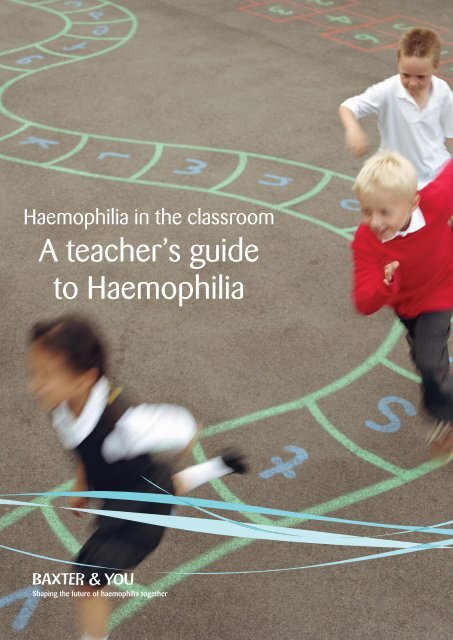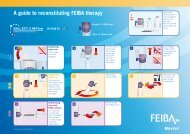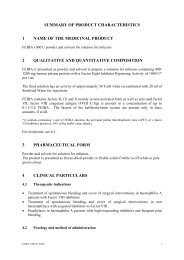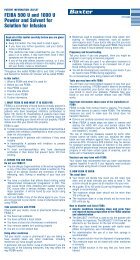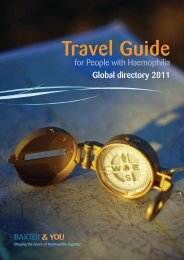Haemophilia in the Classroom - Haemophilia Care
Haemophilia in the Classroom - Haemophilia Care
Haemophilia in the Classroom - Haemophilia Care
- No tags were found...
You also want an ePaper? Increase the reach of your titles
YUMPU automatically turns print PDFs into web optimized ePapers that Google loves.
<strong>Haemophilia</strong> <strong>in</strong> <strong>the</strong> classroomA teacher’s guideto <strong>Haemophilia</strong>Shap<strong>in</strong>g <strong>the</strong> future of haemophilia toge<strong>the</strong>r22
A teacher’s guide to <strong>Haemophilia</strong><strong>Haemophilia</strong> is a rare condition. Largely because it is so rare, <strong>the</strong>re are a lot of mythsand misconceptions about haemophilia firmly lodged <strong>in</strong> many people’s m<strong>in</strong>ds. Like mostsuch misconceptions, <strong>the</strong>se can make life much more difficult, for both <strong>the</strong> person withhaemophilia and for those around him (or her), than <strong>the</strong> condition warrants.This booklet is to help you and your pupils, by giv<strong>in</strong>g you <strong>the</strong> <strong>in</strong>formation you require toensure that <strong>the</strong> child with haemophilia, or o<strong>the</strong>r <strong>in</strong>herited clott<strong>in</strong>g disorder, enjoys andga<strong>in</strong>s as much from school as any o<strong>the</strong>r child.
ContentsWhat is haemophilia? 4How is haemophilia <strong>in</strong>herited?How does haemophilia affect clott<strong>in</strong>g? 6What are <strong>the</strong> effects of haemophilia? 9How will haemophilia affect school<strong>in</strong>g? 10Playgroup/Nursery, Infants and Primary schoolSecondary schoolWhat should teachers look out for? 12Cuts, grazes and bruisesNose bleedsBleed<strong>in</strong>g from <strong>the</strong> tongue, or <strong>in</strong> <strong>the</strong> mouthJo<strong>in</strong>t bleedsHead <strong>in</strong>juries 14M<strong>in</strong>or head <strong>in</strong>juriesSerious head <strong>in</strong>juriesRecognis<strong>in</strong>g a bleed 16At Playgroup/Nursery, Infants and Primary schoolWhat are <strong>the</strong> signs of bleeds?At Secondary schoolWhat to do<strong>Haemophilia</strong> <strong>in</strong> <strong>the</strong> classroom poster 17Personal Details 19
A teacher’s guide to <strong>Haemophilia</strong>What is haemophilia?<strong>Haemophilia</strong> is an <strong>in</strong>herited genetic disorder, affect<strong>in</strong>g only about 6500 people <strong>in</strong> <strong>the</strong>UK, which can lead to <strong>in</strong>adequate clott<strong>in</strong>g of <strong>the</strong> blood <strong>in</strong> response to any form of<strong>in</strong>jury. The defective gene responsible controls <strong>the</strong> production of <strong>the</strong> prote<strong>in</strong>s <strong>in</strong> <strong>the</strong>blood, called clott<strong>in</strong>g factors, which control blood clot formation.How is haemophilia <strong>in</strong>herited?This gene is carried on <strong>the</strong> X sex chromosome. All females have twoX chromosomes, whereas males have one X and one Y chromosome.This difference determ<strong>in</strong>es <strong>the</strong> sex of <strong>the</strong> person.Because <strong>the</strong> haemophilia gene is on <strong>the</strong> X chromosome, it can be passed to <strong>the</strong>child by ei<strong>the</strong>r <strong>the</strong> fa<strong>the</strong>r or <strong>the</strong> mo<strong>the</strong>r. A man with haemophilia, married to awoman with normal X chromosomes, would have sons with his Y chromosomesand <strong>the</strong>ir mo<strong>the</strong>r’s X chromosomes, and would not <strong>the</strong>refore have haemophilia.His daughters would not ei<strong>the</strong>r, because although <strong>the</strong>y would have <strong>in</strong>herited hisdefective X chromosome, <strong>the</strong> normal one <strong>in</strong>herited from <strong>the</strong>ir mo<strong>the</strong>r wouldoverride <strong>the</strong> defect. However, <strong>the</strong>y would still be carriers of <strong>the</strong> condition, ableto pass it on to <strong>the</strong>ir children.Because a carrier has one normal and one defective X chromosome, <strong>the</strong>re is a50:50 chance of <strong>the</strong> haemophilia gene be<strong>in</strong>g passed to her children. As a resul<strong>the</strong>r sons will have a 50:50 chance of hav<strong>in</strong>g haemophilia, and her daughters a50:50 chance of be<strong>in</strong>g carriers.Because of this <strong>in</strong>heritance pattern, haemophilia runs <strong>in</strong> families. If you have a childwith haemophilia <strong>in</strong> your school, it is quite possible that any bro<strong>the</strong>rs or cous<strong>in</strong>she has will also be affected. Equally, any sisters could be carriers. Carriers mayoccasionally show signs of mild haemophilia <strong>the</strong>mselves, but this is unusual.It is <strong>the</strong>oretically possible for a girl to have full haemophilia, but this can happen onlyif she is <strong>the</strong> child of a carrier mo<strong>the</strong>r and a haemophiliac fa<strong>the</strong>r. As you might expect,this is quite rare.04
FemaleMale with haemophiliaX X X YX X X Y X XX YFemale carrier Male Female carrier MaleFemale CarrierMaleX X X YX X X Y X XX YFemaleMale withhaemophiliaFemale carrierMale05
A teacher’s guide to <strong>Haemophilia</strong>How does haemophilia affect clott<strong>in</strong>g?Blood clott<strong>in</strong>g is a complex process, <strong>in</strong>volv<strong>in</strong>g many factors which are identifiedby Roman numerals.These factors are activated <strong>in</strong> sequence <strong>in</strong> response to <strong>in</strong>jury, each serv<strong>in</strong>g toactivate <strong>the</strong> next, ra<strong>the</strong>r like a row of dom<strong>in</strong>oes knock<strong>in</strong>g each o<strong>the</strong>r over.The amount of each factor produced can activate a much larger quantity of <strong>the</strong>next, so <strong>the</strong>re is also a snowball effect, end<strong>in</strong>g up with fibr<strong>in</strong> which forms <strong>the</strong> clot.Clott<strong>in</strong>g factors are activated when <strong>the</strong>blood vessel is damagedBlood vesselis damagedOne factor activates <strong>the</strong> next untila clot is formedA blood clotis formedThere are two ma<strong>in</strong> types of haemophilia depend<strong>in</strong>g upon which clott<strong>in</strong>g factor isaffected. About 80% of <strong>in</strong>stances result from a deficiency <strong>in</strong> Factor VIII which isreferred to as <strong>Haemophilia</strong> A or Classical <strong>Haemophilia</strong>. The rema<strong>in</strong><strong>in</strong>g 20% resultfrom a deficiency <strong>in</strong> Factor IX, called <strong>Haemophilia</strong> B or Christmas Disease.Because <strong>the</strong>se factors work near <strong>the</strong> middle of <strong>the</strong> cha<strong>in</strong>, <strong>the</strong> clott<strong>in</strong>g processstarts as normal, but cannot be completed.The result of this is that, while people with haemophilia do not bleed any moreprofusely than anyone else, <strong>the</strong> bleed<strong>in</strong>g goes on longer.06
There are a number of o<strong>the</strong>r <strong>in</strong>herited clott<strong>in</strong>g disorders caused by deficiency ofo<strong>the</strong>r coagulation factors, most of which are extremely rare, and produce abnormalbruis<strong>in</strong>g and bleed<strong>in</strong>g from mucous membranes, such as <strong>the</strong> <strong>in</strong>side of <strong>the</strong> mouth.The only two which are at all common are Factor XI deficiency, which is seen <strong>in</strong>about 4% of Ashkenazi Jews, and von Willebrand Disease, which may be seen <strong>in</strong>as many as 1 <strong>in</strong> 1000 of <strong>the</strong> population.Factor XI deficiency may go completely unnoticed until <strong>the</strong> person with it hasto undergo surgery, especially to <strong>the</strong> mouth and throat or <strong>the</strong> ur<strong>in</strong>ary tract, butsometimes spontaneous bleed<strong>in</strong>g may occur.The majority of people with von Willebrand Disease, even though <strong>the</strong>y tend tobleed for ra<strong>the</strong>r longer than normal, may also go through most of <strong>the</strong>ir life withoutrealis<strong>in</strong>g <strong>the</strong>re is anyth<strong>in</strong>g wrong. It is often only when <strong>the</strong>y are found to bleedexcessively after hav<strong>in</strong>g a tooth out or after surgery that <strong>the</strong> condition is spotted.In <strong>the</strong> few people with severe von Willebrand Disease <strong>the</strong>re may be haemophilia-likesymptoms, and <strong>the</strong>se people need <strong>the</strong> same sort of precautions as thosewith haemophilia.Early stages areactivated as normalDefectiveFactor VIII or IXBecause Factor VIII or IX is defectiveno clot is formedBlood vesselis damagedNo blood clotformed07
A teacher’s guide to <strong>Haemophilia</strong>What are <strong>the</strong> effects of haemophilia?It all depends on how severe <strong>the</strong> condition is.People with mild or moderate haemophilia do not really have many problems.Even though <strong>the</strong>ir blood clots more slowly than normal, <strong>the</strong> difference is onlylikely to cause concern after serious <strong>in</strong>juries or dur<strong>in</strong>g major surgery.Indeed, many of <strong>the</strong>se people are totally unaware that <strong>the</strong>y have haemophilia,and <strong>the</strong>ir condition would almost certa<strong>in</strong>ly not be such as to require any specialapproach on your part.However, <strong>in</strong> people with severe haemophilia, <strong>the</strong> clott<strong>in</strong>g mechanism is socompromised that <strong>the</strong>y can bleed even when <strong>the</strong>re is no obvious sign of <strong>in</strong>jury.The ma<strong>in</strong> problem is not from open cuts but from <strong>in</strong>ternal bleed<strong>in</strong>g.All of us damage small blood vessels <strong>in</strong> <strong>the</strong> course of everyday life and for mostof us, this causes no problem at all, as <strong>the</strong> bleed<strong>in</strong>g stops and <strong>the</strong> damage isrepaired–often before we even know it has started.For <strong>the</strong> person with haemophilia, once bleed<strong>in</strong>g starts, it goes on for longer,mean<strong>in</strong>g that even trivial <strong>in</strong>juries can lead to bleed<strong>in</strong>g <strong>in</strong>to <strong>the</strong> muscles and jo<strong>in</strong>ts,caus<strong>in</strong>g <strong>the</strong>m to become <strong>in</strong>flamed, swollen and pa<strong>in</strong>ful.An <strong>in</strong>cident such as this is referred to as ‘a bleed’ and requires treatment with an<strong>in</strong>travenous <strong>in</strong>fusion of <strong>the</strong> blood clott<strong>in</strong>g factor which is miss<strong>in</strong>g. Because repeatedbleeds can also lead to long term damage, particularly to <strong>the</strong> jo<strong>in</strong>ts, many peoplewith haemophilia now receive regular <strong>in</strong>fusions of factor, usually twice or threetimes a week, to prevent bleeds occurr<strong>in</strong>g <strong>in</strong> <strong>the</strong> first place. This type of treatment,called prophylaxis, is usually effective <strong>in</strong> prevent<strong>in</strong>g bleed<strong>in</strong>g which occurs for noobvious reason (spontaneous bleeds), and will reduce <strong>the</strong> severity of bleed<strong>in</strong>g asa result of <strong>in</strong>jury to a level close to that of any o<strong>the</strong>r child.09
A teacher’s guide to <strong>Haemophilia</strong>How will haemophilia affect school<strong>in</strong>g?Fortunately, because of <strong>the</strong> effectiveness of modern treatment, haemophilia shouldnot have a serious impact on <strong>the</strong> child’s education. It is important that <strong>the</strong> schoolshould have a good understand<strong>in</strong>g of <strong>the</strong> possible problems, and should build arelationship of mutual trust between teachers and pupil. Children with haemophiliaare no different from any o<strong>the</strong>r <strong>in</strong> look<strong>in</strong>g for any excuse to get out of lessons andactivities <strong>the</strong>y don’t like–if <strong>the</strong>y th<strong>in</strong>k <strong>the</strong>y can get away with a fictitious bleed, <strong>the</strong>ymay try it.That said, and although it is just as important for children with haemophilia as it isfor any o<strong>the</strong>r to attend as much and as regularly as possible, <strong>the</strong>re may be timeswhen <strong>the</strong>y have to miss school while <strong>the</strong>y recover after a bleed, or <strong>in</strong> very rarecircumstances <strong>the</strong>y may require some type of aid such as a wheelchair or crutches.The school should be aware of this and have <strong>the</strong> necessary arrangements <strong>in</strong> placebefore <strong>the</strong> event. Naturally, as a teacher you will want to do all you can to helpa child who has been absent to catch up on missed work and get back <strong>in</strong>to <strong>the</strong>sw<strong>in</strong>g of classes.The aim is always to <strong>in</strong>volve <strong>the</strong> child with haemophilia, and to concentrate on all<strong>the</strong> th<strong>in</strong>gs he/she can do ra<strong>the</strong>r than <strong>the</strong> odd one or two that <strong>the</strong>y can’t. These will,of course, vary not only with <strong>the</strong> severity of <strong>in</strong>dividual cases, but also with <strong>the</strong> age,ambitions and talents of <strong>the</strong> child.In general, most school-based activities can be enjoyed by <strong>the</strong> child withhaemophilia, however, it is worth consult<strong>in</strong>g with parents about participation withcontact sports–and parents may choose to give prophylaxis on P.E. or sports days.10
Nose bleedsThese may normally be stopped by apply<strong>in</strong>g firm pressure to <strong>the</strong> affected nostril for10–20 m<strong>in</strong>utes, or with an ice pack applied to <strong>the</strong> bridge of <strong>the</strong> nose for a maximumof 5 m<strong>in</strong>utes, or both, while <strong>the</strong> child is kept sitt<strong>in</strong>g upright. If <strong>the</strong>se measuresdo not succeed, <strong>the</strong>y should be referred back to <strong>the</strong>ir parents or to <strong>the</strong>ir<strong>Haemophilia</strong> Centre.Bleed<strong>in</strong>g from <strong>the</strong> tongue, or <strong>in</strong> <strong>the</strong> mouthAny bleed<strong>in</strong>g with<strong>in</strong> <strong>the</strong> mouth is harder to deal with because any clots that formtend to be ei<strong>the</strong>r dislodged by <strong>the</strong> tongue or food, or washed away by <strong>the</strong> saliva.Suck<strong>in</strong>g an ice cube may work, but usually bleed<strong>in</strong>g <strong>in</strong>side <strong>the</strong> mouth will needtreat<strong>in</strong>g at <strong>the</strong> <strong>Haemophilia</strong> Centre.Jo<strong>in</strong>t bleedsOlder children should be able to tell you <strong>the</strong>mselves if <strong>the</strong>y are hav<strong>in</strong>g a bleed.Younger ones may <strong>in</strong>dicate that <strong>the</strong>re is a problem by appear<strong>in</strong>g upset or by‘protect<strong>in</strong>g’ a limb by limp<strong>in</strong>g or not us<strong>in</strong>g it. The commonest sites for jo<strong>in</strong>t bleedsare: shoulder, elbow, wrist, hip, knee, ankle and <strong>the</strong> ma<strong>in</strong> signs are:• Pa<strong>in</strong> or a ‘funny feel<strong>in</strong>g’• Swell<strong>in</strong>g of <strong>the</strong> affected jo<strong>in</strong>t or muscle• Heat over <strong>the</strong> affected jo<strong>in</strong>t or muscle• Loss or impairment of movementJo<strong>in</strong>t or muscle bleeds should be treated by <strong>the</strong> parent or <strong>Haemophilia</strong> Centreas quickly as possible.Any bleed around <strong>the</strong> face, neck or throat must be treated as an emergencyand treated immediately by ei<strong>the</strong>r parents or <strong>the</strong> <strong>Haemophilia</strong> Centre.13
<strong>Haemophilia</strong> <strong>in</strong> <strong>the</strong> classroomRecognis<strong>in</strong>g a bleedAt Playgroup/Nursery, Infants and Primary schoolIf <strong>the</strong> child is miserable and/or cry<strong>in</strong>g for no apparent reason, check for <strong>the</strong> signs of a bleed.At Secondary schoolAs <strong>the</strong>y grow, most children with haemophilia will be well able to identify <strong>the</strong> signs for<strong>the</strong>mselves and know if <strong>the</strong>y are hav<strong>in</strong>g a bleed. However, <strong>the</strong>y may sometimes be unwill<strong>in</strong>gto call your attention to any problem, so you need to look out for uncharacteristic quietnessor hampered mobility and check for <strong>the</strong> same signs as <strong>in</strong> younger children.If <strong>in</strong> doubt, contact <strong>the</strong> child’s parents or <strong>Haemophilia</strong> Centre.What are <strong>the</strong> signs of bleeds?Muscle and jo<strong>in</strong>t bleeds• The area may feel tight, warm or swollen• The limb is often pa<strong>in</strong>ful, stiff or difficult to extend• The limbs may be unequal <strong>in</strong> appearanceBumps to <strong>the</strong> head• There may be an obvious lump, swell<strong>in</strong>g or bruis<strong>in</strong>g• There may be no obvious mark at all–but always contact <strong>the</strong> parentsor seek help from <strong>the</strong> <strong>Haemophilia</strong> CentreMouth, gastro<strong>in</strong>test<strong>in</strong>al (GI) and ur<strong>in</strong>ary tract bleeds• Visible bleed<strong>in</strong>g from mouth or tongue• Bloody or black tar-like motions• Red or brown ur<strong>in</strong>eWhat to do• Call <strong>the</strong> child’s parents and/or• Call <strong>the</strong> child’s <strong>Haemophilia</strong> Centre for advice• If <strong>the</strong>re is swell<strong>in</strong>g or discomfort, apply an ice pack to <strong>the</strong> affected area. A bag offrozen vegetables or ice cubes wrapped <strong>in</strong> a towel make an effective substitute• Never give any medic<strong>in</strong>e conta<strong>in</strong><strong>in</strong>g aspir<strong>in</strong> (acetylsalicylic acid).Aspir<strong>in</strong> slows clott<strong>in</strong>g and will make <strong>the</strong> problem worseChildren with haemophilia should be treated just like any o<strong>the</strong>r child.Just be a little extra vigilant so you can learn to recognise bleeds.CUT HEREIf you are worried, unsure or need help, always call <strong>the</strong> <strong>Haemophilia</strong> Centre<strong>Haemophilia</strong> Centre:Telephone:18Contact:18
A teacher’s guide to <strong>Haemophilia</strong><strong>Haemophilia</strong> Centre Details<strong>Haemophilia</strong> CentreTelephone NumberContact NameAddressParent/Guardian Contact DetailsPrimary contactRelationshipHome Telephone NumberWork Telephone NumberMobile NumberE-mail AddressParent/Guardian Contact DetailsSecondary contactRelationshipHome Telephone NumberWork Telephone NumberMobile NumberE-mail Address19
Thanks to <strong>the</strong> UK <strong>Haemophilia</strong> Nurs<strong>in</strong>g Communityfor <strong>the</strong>ir help with this publication.<strong>Haemophilia</strong> Society Helpl<strong>in</strong>e – 0800 018 6068www.haemophiliacare.co.ukShap<strong>in</strong>g <strong>the</strong> future of haemophilia toge<strong>the</strong>rADV08/2234BOctober 2008


